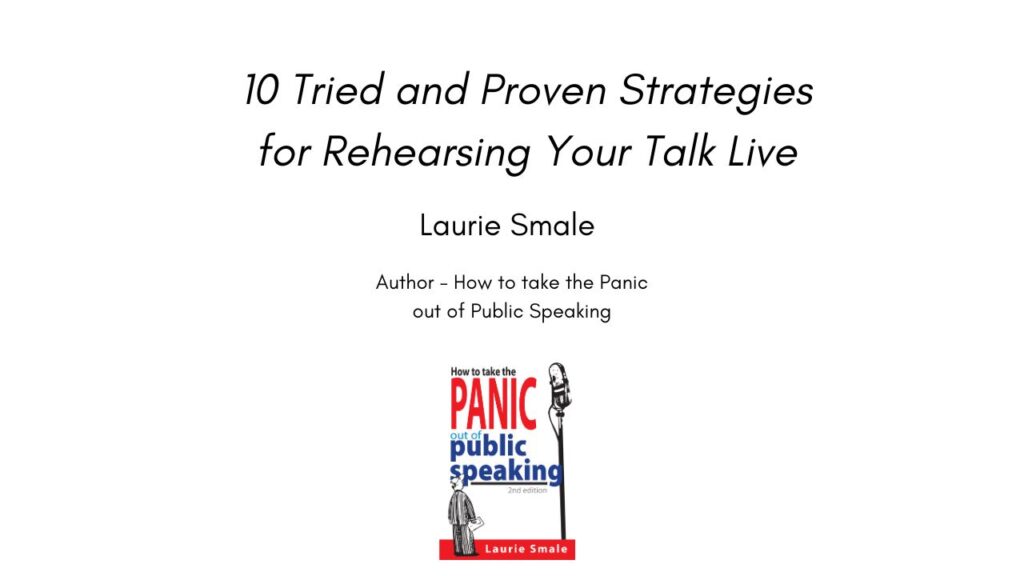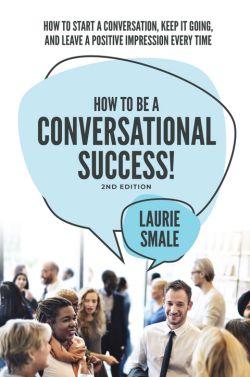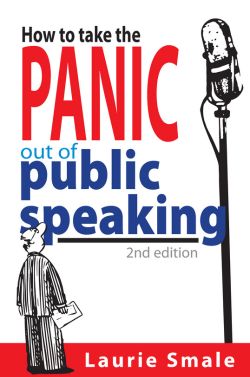10 Tried and Proven Strategies for Rehearsing Your Talk Live
Much has been said about rehearsing your talk till you get it right. But what if you’re rehearsing the wrong things with the wrong voice inside your head? And what are the right things? And how do you rehearse them? This insightful article explains 10 tried and proven strategies for rehearsing your talk live.
1. It’s not all about You: The fact is your listeners have their own problems to contend with and simply want a touch of hope and security from your talk. They don’t really care about your ‘correct use’ of body language and the technicalities of speaking, nor your inner fear of being found out as a bit of fraud. They just want to hear what you have to say.
I wasted decades of my life worried about my level of education and the side of the tracks I’d come from, but not anymore. I now recognise my accumulated experience and expertise. My journey is now my own font of hard-earned wisdom from which I draw inspiration. Make sure you see yourself in this light too!
2. Create a connection: Before we can rehearse effectively we have to push all this negative stuff aside and understand that audiences aren’t looking for perfection they’re looking for connection. They want a real, imperfect, fallible human being to talk with them…someone they can relate to and who has earned the right to be there. Now with our focus where it should be – on our listeners and what our message means to them – we’re ready to rehearse so our words and thoughts resonate on a human level.
3. Relax in your favourite chair: Whenever I speak in front of an audience or conduct a workshop I make sure I run through my entire talk ‘live’ a few times beforehand. I actually trick my mind into believing I’ve been with this audience before so that when I step onto the platform I’ve created a comfort zone within myself and the situation no longer frightens me. Here’s how I go about it.
I wait until I’m completely alone with no distractions. Then when I’m nice and relaxed in my favourite chair, I mentally take myself to the venue – with my eyes open. I imagine myself sitting among the audience, a little keyed-up sure… yet I feel good about where I’ve been, who I am, why I’m there and what I’m about to say. I see a room full of friendly people enjoying themselves and can sense an atmosphere of excited expectancy. Most of all I remind myself that these people are my friends and have gone out of their way to learn from what I’ve got to say… No one is there to do me any harm.
4. Talk to key ideas: With all this in mind, I read through my first draft a few times, not to memorise it by heart, but to feel at home with my audience, my main ideas, those all-important bridging thoughts from one main idea to the next, and some key terms and phrases. This phase usually takes a couple of sittings of twenty minutes or so. When I’m comfortable with this, I reduce this original draft down to a few key mental joggers. From this point onwards I’ll rehearse to these key points (not my first draft), although I still keep my written draft handy to refer to and make ongoing adjustments. Remember that your talk is never static. It’s a dynamic living thing. Now I’m ready to rehearse to my key ideas ‘live’.
5. Take the pressure off you with your opening: Still visualizing myself at the venue, I’m a little keyed up but accept this as perfectly normal. As I hear myself being introduced I feel that familiar rush of adrenalin surge through my body. I hear the welcoming applause and confidently step forward, thank the person who introduced me, deliberately pause to take in the audience – and begin to speak. My all-important opening is a question or statement that instantly gets them thinking to take the pressure off me and get me safely through that initial adrenalin barrier.
The only parts of my talk that are memorised are the opening and closing remarks and the transitional phrases that link my ideas together. In the body of my talk I’m not concerned with the exact words I use, I just mull over my key ideas and let the words flow as they would in normal conversation. I sense the ever-changing mood as I introduce each new idea and involve my listeners in each new story. I sprinkle my talk with ‘feeler questions’ like “can anyone relate to that” to get the heads nodding and keep them engaged. I see their faces and feel the warm rapport. And each time I rehearse, the words are ever so slightly different ensuring a spontaneous freshness about my talk. I even anticipate the little asides and ad lib bits!
6. Prepare your ending: I conclude with a carefully chosen story, summary, quote, summary, or saying that encapsulates the essence of my message and leaves my listeners with something of substance to think about. As I make my way back to my seat the comments and generous applause tell me that I’ve appealed to both heart and mind. All of this takes about 10 to 15 minutes because the mind fast forwards and rewinds a lot of your ideas.
The secret is to spend this time with your talk at least once a day for a few days before you speak. Rarely do I rehearse the whole talk without a break. I reflect between ideas and add the occasional key word or phrase to my list of mental joggers and first draft as I go. At other times I find myself on my feet talking out loud or interacting with a room full of imaginary people.
7. Forget the mirror and video! You’ve probably noticed that I haven’t mentioned the use of a mirror or video to rehearse your talk. There’s a very good reason for this. I find it very off-putting and unnatural to see my image trying to be a ‘public speaker’ in front of me. No one puts a mirror in front of you during your talk to distract you so why rehearse with one! Instead use your mind’s eye to focus on how your listeners are responding to your message and rehearse to that.
And the same goes for rehearsing in front of a video camera. Here you run the very real risk of reinforcing long-held negative beliefs of how bad you look and how awful you sound. “I knew it!” I’ve heard people lament when they see themselves played back on video during a training session, “I look and sound horrible!” I firmly believe that the intimidating presence of a video camera as a training tool for public speakers can do great damage by further locking ingrained self-doubt and anxieties in place.
Having your talk video recorded for posterity on the night from a distance is fine because this is non-intrusive and allows you to be you. But being forced to ‘be natural’ in front of a video camera during a training session when you’re not used to it is quite another matter.
If you have to engage in video or television interviews remember that you’re still speaking to a group of warm human beings although your speaking space is reduced to a smaller square. The secret is to see all this in your mind’ eye as you rehearse. Never forget that the power of the spoken word comes from the heart not clever camera work or a director’s insights. When rehearsing, as with mirrors, it’s best not to use videos.
8. Don’t try and be perfect: At the end of a coaching session on public speaking with one of Australia’s leading acrobats, she said to me: “This is fantastic! I’m now going to rehearse until I have it perfect”. I cautioned against it. “This is not a circus performance where each movement has to be painstakingly rehearsed for many months because of a life-and-death necessity. This is all about creating intuitive rapport with people and relating to them on a human level. Your rehearsal should anticipate – actually visualize – some spontaneous interaction and asides”. I got her to understand that speaking before groups is not about being a technically perfect performance… yet it can still infect people with her enthusiasm and fire them with her passion! What was said earlier in this article is worth repeating: Your listeners are looking for connection not perfection!
9. Run through your opening one last time: There’s one really important thing to do beforehand. On the way to the venue I go over my opening words one final time to make sure I’ve got them off pat. For what was rehearsed yesterday has a tendency to go cold over night. My list of key mental joggers will remind me of what example to use and keep me on track throughout my talk, but what I say first always needs some last minute refinement to ensure I’m comfortable with my opening ideas. After all, they’re the words that will not only grab my listeners’ attention and get them interested… they share the pressure around and get me safely through that initial adrenalin barrier to enjoy the rest of my talk. These proven tips can do the same for you.
10. Rehearse your stories with others: I was once part of a small dinner group hosting an international guest who was to speak at our conference the following day. As we chatted across the table I was very impressed with his knowledge of Australia and the stories he shared. When he spoke the next day I was surprised to hear most of what he’d rehearsed with us over dinner! So rehearse your stories in everyday conversation with family and friends to gauge their reactions.
These tried-and-proven public speaking tips reflect the exciting outcomes embodied in my second edition best-selling classic book, ‘How to take the Panic out of Public Speaking.’

© Laurie Smale Inspirational Speaker, Speaking Coach, and Author
ARTICLE // 10 Tried and Proven Strategies for Rehearsing Your Talk Live.
By Laurie Smale, Author, How to take the panic out of public speaking 🎤
- It’s not all about You
- Create a connection
- Relax in your favourite chair
- Talk to key ideas
- Take the pressure off you with your opening
- Prepare your ending
- Forget the mirror and video!
- Don’t try and be perfect
- Run through your opening one last time
- Rehearse your stories with others
Read all the details at https://lauriesmale.com/blog/article-10-tried-and-proven-strategies-for-rehearsing-your-talk-live
All of my practical coaching wisdom is in my three books available at https://lauriesmale.com/books
#lauriesmale #article #howtotakethepanicoutofpublicspeakingbook #publicspeaking #rehearsingyourtalk
Shared Online Archive.org Facebook Page Facebook Profile Google LinkedIn Page LinkedIn Profile Twitter / X








